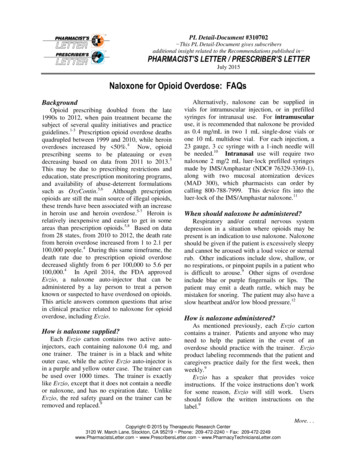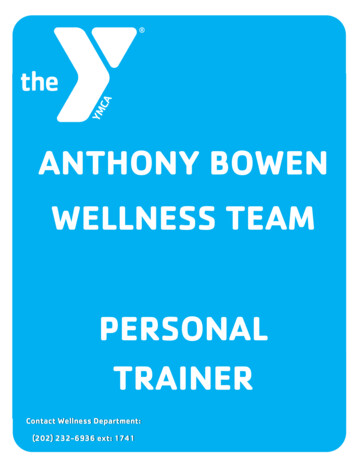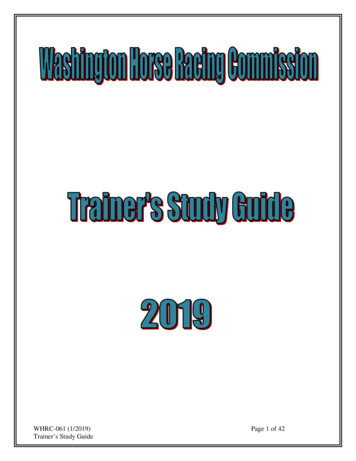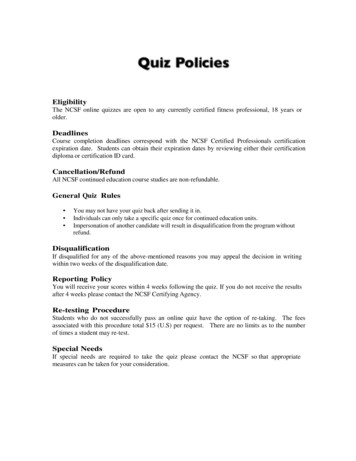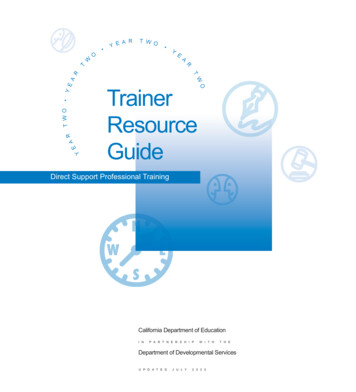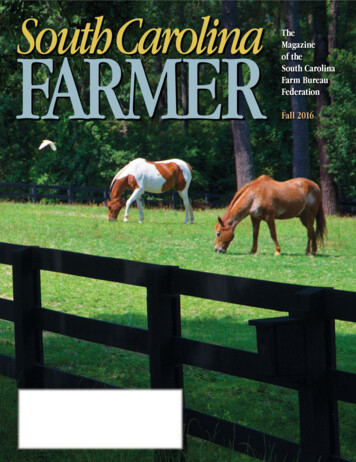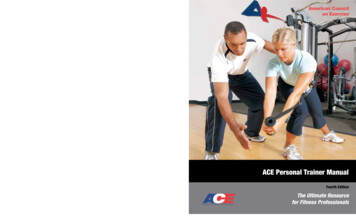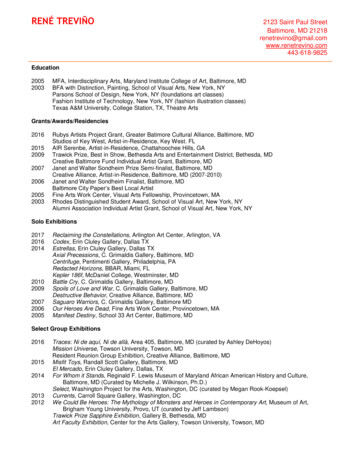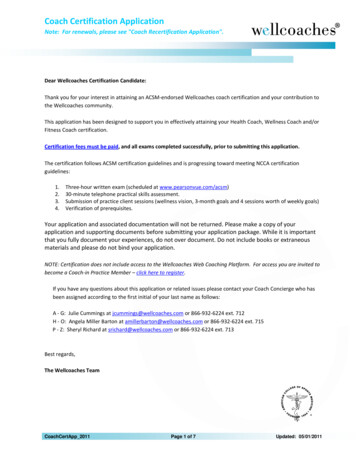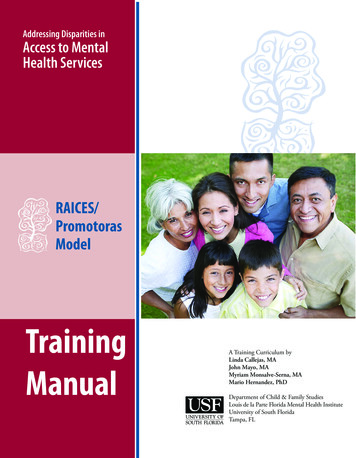
Transcription
Addressing Disparities inAccess to MentalHealth ServicesRAICES/PromotorasModelTrainingManualA Training Curriculum byLinda Callejas, MAJohn Mayo, MAMyriam Monsalve-Serna, MAMario Hernandez, PhDDepartment of Child & Family StudiesLouis de la Parte Florida Mental Health InstituteUniversity of South FloridaTampa, FL
RAICES/PromotorasModelThis publication was produced as partof the RAICES/Promotoras FieldInitiated Research Project, supported bythe Children’s Board of HillsboroughCounty and funded by the NationalInstitute on Disability and RehabilitationResearch, U.S. Department of Education,in partnership with the Department ofChild and Family Studies, Louis de laParte Florida Mental Health Institute,University of South Florida (sub-contract#35049-0S-275) with financial supportfrom the Substance Abuse and MentalServices Administration, U.S. Departmentof Health and Human Services (SAMHSAPhase III Contract #280-99-8023).Recommended Citation:Callejas, L., Mayo, J., Monsalve-Serna, M., & Hernandez, M. [2006]. Linkingcommunity helpers & services with schools serving Latino families: Anorientation to the RAICES/Promotoras model and associated trainingcurriculum (FMHI pub. no. 246). Tampa, FL: University of South Florida,Louis de la Parte Florida Mental Health Institute. Available n.pdf.2 RAICES/Promotoras
RAICES/ Promotoras Model Training Manual ContentsIntroductionSection 1.1 – Introduction to Family and School Support Teams (FASST)Section 1.2 – What is a System of Care?Section 1.3 – Wraparound Values and PrinciplesSection 1.4 – Ethics and ConfidentialityChapter 1Section 2.1 – What Is Culture?Section 2.2 – Principles of Cultural CompetenceSection 2.3 – Culturally Competent PracticeSection 2.4 – Culturally Competent Service DeliveryChapter 2Section 3.1 – Understanding Elementary Schools in Hillsborough CountySection 3.2 – Exceptional Student Education Program (ESE)Section 3.3 – English for Speakers of Other Languages Program (ESOL)Chapter 3Section 4.1 – Overall Framework for Child Mental Health and Well-beingSection 4.2 – Child Developmental Domains & MilestonesSection 4.3 -- Healthy Relationships and Nurturing EnvironmentsSection 4.4 – Facilitating Child Mental Health and Well-beingChapter 4Section 5.1 – Essential Components of the Wraparound ProcessSection 5.2 – Implementing WraparoundSection 5.3 – Utilizing Family Strengths in WraparoundSection 5.4 – The Family TeamChapter 5Section 6.1 – Case Management: The BasicsSection 6.2 – Collaboration with Providers and AgenciesSection 6.3 – Collaboration with FamiliesSection 6.4 – Monitoring the Family PlanChapter 6Section 7.1 – Home Visits: What to Know Before You GoSection 7.2 – Establishing a Successful Support RelationshipSection 7.3 – The Three Stages of Home VisitingChapter 7Section 8.1 – Assessing Our Use of System of Care ValuesSection 8.2 – Assessing Implementation of Wraparound PrinciplesSection 8.3 – Facilitating Effective Family Team MeetingsChapter 8Training Manual - Table of Contents 3
4 RAICES/Promotoras
IntroductionThe RAICES/Promotoras TrainingManual contains materials foreight structured workshop sessions.This section has been designed tohelp facilitators prepare for leadingworkshop sessions. It includes tips,techniques, and ideas to refresh andstrengthen group leadership skills.PreparationWorkshop facilitators will benefitfrom taking some time to review themanual and the additional resourcesprovided before beginning the trainingsessions. The Resources and Referencessections of this manual contain listingsfor books, articles, web sites, andvideos that may be helpful.LogisticsEach structured session of theRAICES/Promotoras Training coversabout four to six hours of material.Consider the following logistics issuesin your planning and preparation:Training participants – The trainingis designed for individuals whoare employed as Family SupportCoordinators, Parent Advocates,and Promotoras within Family andSchool Support Teams (FASST) inHillsborough County. The material,however, is general enough toaccommodate outreach workersand case managers who workwithin a System of Care or applythe Wraparound Process throughtheir work. Exercises, activities, andhandouts used in the workshoprequire at least a 10th grade readingcomprehension level in English.Meeting room – Tables or desks shouldbe part of the seating arrangements,since many of the training exercisesand activities include writing onworksheets from the manual. Tablesshould be placed in a “U” formationor semi-circle. Other activities will callfor participants to move around theroom or to work in pairs/small groups,so the meeting area should be largeenough to hold everyone comfortably.In addition, the room should offerparticipants a sense of privacy.Equipment – Group leaders willneed a flip chart or a dry erase/chalkboard for writing down key pointsduring discussions and brainstormingactivities.Breaks/refreshments – Offerparticipants a short break (10 minutes)at a logical stopping place duringparticular sessions. (Break times havegenerally been outlined for you withineach chapter.) Providing coffee andother refreshments can add a nicetouch and are generally appreciated bygroup members.The RAICES/Promotoras trainingprogram has been distributed overeight sessions. Each session is designedto last from four to six hours,depending on the materials presented.During the course of their workwith the RAICES/Promotoras trainingTraining Manual - Introduction 1
Guidelines For GivingInstructions Be certain about the goaland the process of theactivity; Tell participants thegoal of each activitybefore giving the specificinstructions; Give instructions inthe form of a request orinvitation instead of as anorder or demand; Give instructions when thegroup is still and quiet soeveryone can hear – makesure you have everyone’sattention first; Give participants a timeframe for each activity; Give one or twoinstructions at a time– avoid a long list ofinstructions; Have instructions clearlywritten as well, and if theyinvolve a list of questions,write these on flipchartsfor everyone to see; Don’t give instructionsthat are too vague orgeneral; Ask participants if theyare clear about whatthey will be doing beforethey begin an exercise oractivity. If they are not,repeat the instructions.program, trainers/facilitators areencouraged to model or demonstratea number of communication skills(listening, I-Messages, nonverbalcongruence). As part of thepreparation process, leaders may find ithelpful to practice with peers and getfeedback on the most useful ways ofmodeling the recommended strategies.Facilitation of the RAICES/PromotorasTraining ProgramAll of the activities that you willfacilitate during this training, fromstart-up to closing activities, willrequire clear and precise instructionsso participants will know what isexpected of them. The need forclear instructions will be importantthroughout the training.This will especially be the casewhen introducing group exercises andactivities. Instead of simply asking thetraining group to form groups anddiscuss an issue, be more specific. Askthe trainees to divide into a specificnumber of groups and give the groupsa set amount of time in which tocomplete an assignment and thenreturn to report findings to the wholegroup. Let participants know that theyhave to limit their comments to theissue at hand. The discussion needs tobe focused so that they can accomplishtheir task in the allotted time. Wheninstructions are clear, participants canmonitor their own behavior.Process of Giving InstructionsThe following guidelines for givinginstructions are presented to help youin your role as facilitator: Be certain about the goal andthe process of the activity; Tell participants the goal of eachactivity before giving the specificinstructions; Give instructions in the form ofa request or invitation instead of2 RAICES/Promotorasas an order or demand; Give instructions when thegroup is still and quiet soeveryone can hear – make sureyou have everyone’s attentionfirst; Give participants a time framefor each activity; Give one or two instructionsat a time – avoid a long list ofinstructions; Have instructions clearly writtenas well, and if they involve alist of questions, write these onflipcharts for everyone to see; Don’t give instructions that aretoo vague or general; Ask participants if they are clearabout what they will be doingbefore they begin an exercise oractivity. If they are not, repeatthe instructions.Facilitating Group ProcessThe pages that follow outline anumber of process skills that you, asthe facilitator, can make use of duringthe training of RAICES/FASSTmembers. These skills can help you tolead group discussions and to handlegroup behavior in order to facilitatea positive and productive learningenvironment throughout the training.Before outlining these skills, it willbe helpful to provide you with someinformation on facilitating groupprocess.Group process is the way thatthings happen in a group. It describesthe various aspects that make upthe learning environment. Thus, itis different from the content beingdiscussed or taught. Group processincludes: Group norms Communication processes The facilitator’s behavior
Participants’ roles and behaviors Decision-making processes Cooperation and competition Stages of group development Degree of group cohesionThere are two forms of groupprocess— member-facilitatorinteractions and member-memberinteractions. Part of your job willbe to make sure that interactionsbetween trainees and yourself, as wellas between the trainees themselves, arerespectful and positive.Member-Facilitator InteractionsAs a facilitator, you want to createan empowerment relationship whereparticipants feel responsible for bothprocess and content of the group.Members respect the knowledge andskills of the facilitator but do notdepend on her/him to provide the“right answers,” approve of opinions,behaviors, or conclusions, or to makedecisions for the group.Member-Member InteractionsIn an empowered group, an equalbalance of participation amongmembers usually reflects their feelingof acceptance and willingness toshare ideas, opinions, feelings, andexperiences. Group cohesion occurswhen members cooperate to achievea common goal. When people areempowered, they feel free to expressviewpoints that conflict with those ofothers. Differing opinions are takeninto consideration: no one position isperceived as “right.” You should keepin mind these ideal characteristicswhen you evaluate the group’s progressand decide what techniques andinterventions are necessary to move thegroup forward.Group DevelopmentResearchers and practitionersgenerally agree that groups movethrough various development stages.Although we will not discuss thesestages in detail, we would like to orientyou to some of the behaviors andprocesses you may encounter as youfacilitate the training sessions.When groups first form,individuals are often unsure abouttheir relationship to other members,the facilitator, and their role in thegroup. Their behavior may reflectanxiety about being accepted by othergroup members. Some people maybe extremely cautious about sharingpersonal information or disclosingopinions. Other members maydominate discussions by talking toomuch or giving too much personalinformation. Your trainees will oftendepend on you, the facilitator, for cuesabout how to behave. At this stage, it is importantfor you to demonstrateempowerment behaviors thatwill help reduce any anxietythat group members may feeland help them feel welcomed.These behaviors include: activelistening; being inclusive ofeveryone; openly appreciatingthe contributions of participants;communicating clearly;maintaining an attitude of trustand openness throughout thediscussion; and keeping a goodsense of humor.EmpowermentBehaviors Include: active listening being inclusive ofeveryone openlyappreciating thecontributions ofparticipants communicatingclearly maintaining anattitude of trustand opennessthroughout thediscussion keeping a goodsense of humor.As training participants becomemore comfortable with their rolewithin the group, conflict can ariseover who will control or influencethe group. Competition amonggroup members and challenges to thefacilitator’s leadership are commonduring this stage. A skilled facilitatorcan minimize challenges by givingonly as much power to participants asthey are able to handle. Conversely,if you seem too rigid with authority,participants will likely challenge youand your efforts.Training Manual - Introduction 3
Help Participants FeelComfortable By: Offering suggestions forhow to view or handlea problem Gathering informationfrom the group Offering informationto the group Summarizing an issueor helping the groupdevelop a theme or idea Writing down ideas,suggestions, positions,or decisions made bythe group Recognizing thecontributions ofgroup members andvalidating individualopinions Offering compromisesor suggestingcreative solutions todisagreements amonggroup members. Keepingcommunication openby inviting quietmembers to speak, orproposing proceduresto give everyone equalspeaking timeResponding to thegroup’s decisions orviews During this stage, it is importantfor you to diffuse competitionamong participants. For example,you can encourage a varietyof opinions and stress that allopinions are valid. You can useproblem solving and consensusbuilding techniques to helppeople find common ground andshared solutions. Create an environment where allparticipants are heard, respected,and valued, even if their opinionsdo not meet with the agreementof others.After a while, the group will beginto coalesce and find more commonground. This final stage of groupdevelopment is often referred to asmaturity. This phase is characterized bythe behaviors of an empowered group,where people work collaborativelyand seek to produce collective workproducts. It is important to notethat groups vary in the amount oftime it takes for groups to reach thefinal stage of group maturity, if at all.However, your goal as facilitator isto help participants feel comfortableenough to work together during thetraining sessions and begin to solidifytheir sense of being part of a team thatwill work together with students andfamilies through FASST.For the purposes of the FASSTtraining, we should focus onreinforcing participant behaviors thathelp facilitate group processes, such as: Offering suggestions for how toview or handle a problem Gathering information from thegroup Offering information to thegroup Summarizing an issue or helpingthe group develop a theme oridea4 RAICES/Promotoras Writing down ideas, suggestions,positions, or decisions made bythe group Recognizing the contributions ofgroup members and validatingindividual opinions Offering compromises orsuggesting creative solutionsto disagreements among groupmembers. Keeping communication open byinviting quiet members to speak,or proposing procedures to giveeveryone equal speaking time Responding to the group’sdecisions or viewsLeading DiscussionsIn addition to the goal ofencouraging participants to draw onand respect their own knowledge,skills, and strengths, as a discussionfacilitator you will need to be clearabout the specific purpose or goal of aparticular discussion. Throughout thistraining, you will use a variety of toolsor techniques including: mini-lectures,family stories, transparencies, visualdiagrams, etc.You may also rely on the followingprompts to stimulate discussion:Asking questions: Once you haveintroduced a topic, ask the groupone or two constructive questions,such as “Have you had experiencewith this?” or “Can this be ofuse to you?” Questions such asthese are a good way to get groupdiscussion started. However, youwant to take care that you don’t asktoo many questions or questionsthat suggest there is a “right”answer. Rather, questions shouldstimulate discussion by addressingthe concerns and experiences of theparticipants.Linking comments: Makinglinking comments is an effective
way to connect what a person hassaid about an idea or concept toanother’s idea. Linking commentshelp validate participants’contributions as something valuableto remember. They also serve asa good way to get participants totalk with one another. By makinglinking comments during the groupdiscussion, you will be encouraginginteraction among participants andincreasing group cohesion.Summary statements: Groupdiscussions are meant to assist withteam building, develop a sense ofpartnership between participants,and build the capacity of the groupto effectively support and servefamilies through FASST. Summarystatements and lists are useful toolsthat help participants know wherethey are in the training process,to get a sense of where they arein the process, for recognizingparticipants’ contributions andclarifying major points, themesand opinions that have beenexpressed. Keeping a running listof key statements on a dry erase orflip chart is a good way to createa visual vehicle for organizingparticipant’s opinions. You maywant to put checkpoints on thoseitems that the group considers mostimportant. Trainers usually writesummary statements at the end of adiscussion or module for maximumimpact, but they can be useful atany point.Making Transitions and Ending Discussions:The facilitator can use a summarystatement as a transition statementto link the discussion to the nextactivity or to relate it to the goalsof the training. Deciding whento end the discussion dependson two factors: (1) time availableand (2) the group’s energy andinvolvement. If the group is tiredor the group has exhausted thediscussion purpose, it may signalthat you should end the processeven if there is still time available.Reading a group’s energy levelby observing the participants’body language and the numberof people still involved in thediscussion is a valuable way foryou to make the decision aboutwhen to end the activity.Group DiscussionsIn large group discussions, yourrole as the facilitator will be tolead an inclusive discussion whereeach individual contributes andis therefore a resource to others.As facilitator, your role will vary.Sometimes, you will serve as aresource person. At other times, theother group members will knowmore about a topic being discussedthan you. If someone has personalexperience in an area, let her/himshare it.An inclusive discussion can: help participants develop asense of group unity encourage development of ashared wisdom among groupmembers enable members to get to knoweach other provide participants with moreideas and options than theymight think of on their own give participants an opportunityto view their own experiencesfrom other perspectives give participants opportunitiesto experience an exchange ofinformation where each personhas something important tocontributeAn Inclusive DiscussionCan: help participantsdevelop a sense ofgroup unity encouragedevelopment ofa shared wisdomamong groupmembers enable members toget to know eachother provide participantswith more ideasand options thanthey might think ofon their own give participantsan opportunityto view their ownexperiences fromother perspectives give participantsopportunitiesto experiencean exchangeof informationwhere each personhas somethingimportant tocontributeA large group discussion is nota debate, an argument, or a simpleconversation. Facilitating a largeTraining Manual - Introduction 5
Small group discussionsprovide an excellentway for FASST trainingparticipants to buildtrust and learn towork cooperatively toaccomplish specific tasks.Through their work insmall groups, FASSTtrainees will have theopportunity to modelcooperation, trust,mutual support, andcommunication.group discussion is not the same asleading a meeting or moderating adebate; rather it is an activity thatincludes numerous viewpoints, as wellas the perspective of the moderator.The challenge for the facilitator is totry to be as inclusive as possible of allof the viewpoints expressed in orderto make individuals feel comfortableenough to participate.The role of the facilitator inlarge group discussions can becomplex. Most often, the facilitator isresponsible for modeling empoweringbehaviors, such as active listening,being inclusive of all participants,openly appreciating participantcontributions, communicating clearly,maintaining an attitude of trust andopenness throughout a discussion, andmaintaining a good sense of humor.Other roles a facilitator may assumeduring a large group discussioninclude: clarifying the purpose or goal ofthe discussion beginning the discussion keeping the discussion relevant tothe topic being discussed keeping the discussion flowing making sure that everyone has anopportunity to participate andcontribute stimulating the discussionthrough intriguing questions giving feedback when needed using the flipchart to record keydiscussion points or statements validating participantcontributions to the discussion modeling empowering behaviorsSmall group discussions providean excellent way for FASST trainingparticipants to build trust and learnto work cooperatively to accomplishspecific tasks. Through their work6 RAICES/Promotorasin small groups, FASST traineeswill have the opportunity to modelcooperation, trust, mutual support,and communication. These skills willhelp them prepare to more effectivelyengage families as partners.Small groups can include pairs,triads, quads, or up to eight trainees.The size of the group will depend onthe number of training participants.The advantages of working withsmall groups include: Each participant has anopportunity to be more involvedin accomplishing a task, seeking asolution, or exploring a topic; Each participant is better able toexpress her/his ideas and opinionand hear responses to them; Each topic or issue can beexamined in more depth; There is greater opportunityfor interaction between groupmembers; All group members can beinvolved in accomplishing a task,which helps to build cooperation; Participants can learn andexchange a variety of alternativesfor problem-solving, and whenthey re-join the large group,everyone benefits from thereports and conclusions; Facilitators get an opportunityto see how participants interactduring small group work and theareas where some individuals mayneed greater support; There is greater opportunity forgroup cohesion and reliance onits members’ ability to work outsolutions.Small group work is appropriatewhen participants need to beable to perform a required tasksuccessfully without direct guidance or
supervision. For small groups to workwell, participants need to receive andunderstand clear instructions. It is alsohelpful to know ahead of time howmany people will be in each group.This decision can be made once youknow the number of trainees for eachsessionGroup Process SkillsRole play is a learning processin which participants act out theroles of other individuals in order todevelop particular skills and to meetparticular learning objectives. It is usedextensively in the structured sessionsto help participants practice new skillsand become comfortable using them.Here are some things to keep in mindwhen leading role play sessions. Youmay find it helpful to use some of thisinformation to prepare your openingdiscussion of role play with groupmembers: Role play is not the same as“drama.” Encourage participantsto be natural and focus onhelping each other create realisticsituations for practicing skills. Stop and start the role play, asneeded. It is sometimes helpfulto focus on just a few lines andresponses, then stop and processthe interaction. After someprocessing, participants canrepeat the scenario, incorporatingthe feedback generated duringthe preceding discussion. When processing a role play,encourage participants to talkabout their feelings as well as theskills being practiced. Teach participants how togive each other helpful andconstructive feedback. Provideexamples. Ask for volunteers for role play.Don’t force anyone to participatein role play. Some people may betoo uncomfortable. Rememberthat some people learn morefrom observing than fromparticipating. Stop the role play if you sensethat a participant is becomingdistressed or uncomfortable. Letparticipants know they can stopor “bow out” of a role play at anytime. When appropriate, you may wantto take part in a role play activity,by modeling effective techniques.Effective use of familystories during thetraining will involvesignificant reflectionand thinking ahead oftime on the part of thefacilitator. Encourage the group to discussboth verbal and nonverbalcommunication in the roleplay scenario. Help stress theimportance of appropriatenonverbal communication foreffective parenting. If the parenting orcommunication techniques usedby a member during the activityare ineffective or inappropriate,ask the participant or other groupmembers for alternatives. Giveexamples. Thank members for participatingin a role play activity. Findopportunities to offer praise andcompliment their willingness totry.Family Story ExerciseA family story exercise is based ona case study that provides informationon a fictional family that may exhibitcharacteristics or experiences similar tothose of families seeking or receivingFASST services. Effective use of familystories during the training will involvesignificant reflection and thinkingahead of time on the part of thefacilitator. In order to prepare for theexercise, you must:1. Review the section that includesthe family story to betterunderstand the content andcontext of each exercise.Training Manual - Introduction 7
An action plan allows forparticipants to considerall of the knowledge andskills they have learnedand to develop a “roadmap” of steps to take oncethey begin their workwith families.2. Read and reflect on the centralthemes of the story: What are the needs of thefamily? What are the strengths of thefamily? How did/can FASSTpersonnel work with thefamily? How was trust built withfamily? What is the family’sidentifying information? What do we know about thefamily’s situation? Are informal and formalsupports available to thefamily? Are there any risks involvedfor the family? What information isavailable? What is missing?3. In addition to the questionslisted above, create your ownlist of questions and pointers sothat you can help participantsthink creatively. Participantsmay get stuck on a family storydue to personal experiences,not enough reflection about thestory itself, or because the storydid not offer much information.If this is the case, encourageparticipants to identify the typesof questions they would ask inthat situation if they could speakwith the family.4. Make a record on a flipchartso that the group can reflecton their responses and discussthem.Action PlansThroughout the training, FASSTpersonnel will gain insight into andan understanding of the activities theywill use to identify family’s needs andhow best to address them. By creatingan action plan at the end of each8 RAICES/Promotorassession, training participants will havethe opportunity to reflect on the goalsand expected outcomes of the training.An action plan allows for participantsto consider all of the knowledge andskills they have learned and to developa “road map” of steps to take once theybegin their work with families. Anaction plan can also help to evaluatethe training process.Here are some steps to creating anaction plan:1. Begin by asking participants toorganize themselves into groupsof three individuals. They shouldthen discuss what they learnedduring today’s session.2. Prompt them by askingquestions like, “What was oneof the most important thingsyou learned today?” Uponreceiving their responses, reviewspecific information or activitiespresented and record some ofthese responses on the flip chart.3. After you have recorded theirfeedback, you might ask, “Whatare some of the ideas and goalsthat you developed during thissession that you would like toimplement?”4. Ask them to make a list of all ofthe answers they come up withfor this question. Each idea/goalmust be numbered. Tell themthat they can use both sidesof the Action Plan worksheetto provide responses. Theirresponses can relate to personalgoals, family-oriented activities,or work in the community.5. When participants are finishedlisting their ideas/goals, ask themto write the heading “ActionBarriers” on their worksheets.Then ask them to list all of thebarriers they might encounterwhen they try to implement thesegoals in the field. Keeping thesebarriers in mind, how might they
go about trying to accomplishtheir goals?6. Ask them to mark the barriersthat they believe cannot beaccomplished with an asterisk,“*”. Ask them to underline thebarriers that they believe will beeasy to accomplish.7. Next, ask participants to sharethose barriers they think will bemost difficult to overcome (thosemarked with an asterisk). Writethese responses on the flip chart.administer the pre-test and post-testquestionnaires, time should be allowedbefore and after each session. The samequestionnaire should be used for bothpre-test and post-test administration.(The facilitator or evaluator canidentify whether it’s being given as“Pre-Test” or “Post-Test” at the top ofthe form).8. Ask them to share those goalsthat can be implemented easily(the ones that are underlined).Ask participants to share thesegoals and the barriers theyassociate with them, as well.9. Ask the group to try to find waysto overcome the barriers theyidentified. If there is enoughtime, ask each person to share anindividual action plan with thegroup.10. Close the exercise emphasizingthe positive ways in which goalscan be met. Note: An ActionPlan Worksheet and theseinstructions are included at theend of each chapter.EvaluationEvaluation Survey: There will bean evaluation survey administeredto partici
for books, articles, web sites, and videos that may be helpful. Logistics Each structured session of the RAICES/Promotoras Training covers about four to six hours of material. Consider the following logistics issues in your planning and preparation: Training participants - The training is designed for individuals who are employed as Family .


